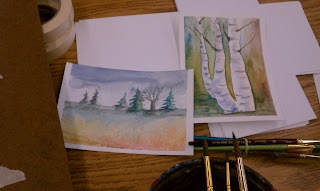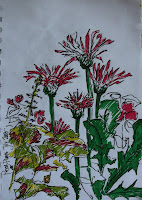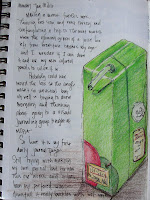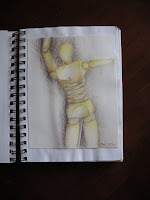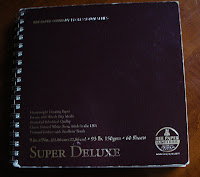I spent this last Friday in my classroom demonstrating drawing (mark making) with multiple mediums for my advanced drawing students as a preparation for creating an expressive self portrait (their first project). I had every possible art supply available for them and I worked on the small projects here as examples while they worked on their own small experiments using fruit as subjects.
The goal was to get them to mix mark making materials and collage to create interesting and unexpected results. Using fruit allowed them to quickly draw the subject and focus on mark making and experimenting with new mediums. As I made discoveries I shared them and I encouraged them to do the same with each other, as sometimes what works or doesn't work is all a matter of perspective.
The apples were mostly examples made while discussing techniques and properties of a particular medium while students watched. The pears in the longer piece above was what I was working on after they all got to work. I always love working along side my students and this little project took me through the day as I continued to explore and demonstrate mixing mediums together in the same piece of work. Students also got to see me make decisions as I moved through the work, particularly as I got the the collage portions, as before i glued anything down I had several options that I played with on the page.
Cream Canson Mi-Teintes
approximately 5x6"
Newspaper collage,
Sharpie pen sketch with white gel pen accent,
Brush pen sketch with watercolor wash and soft pastel detail work
As I worked I was experimenting with the idea of using multiple views of the same object within the same drawing. I also knew I wanted to include collage, and was trying to encourage my students to do the same, although they were more reluctant than I was to try something completely new. As far as new to me things from Friday, I used white gel pen, gouache, and soft pastels for the first time.
The colored apple on the example above was sketched with the Pentel Pocket Brush Pen; then I used some watercolors to paint the apple and the background a bit; next I used some pastels to add to the shadows and stem area and finished up with some more Brush Pen. I like the way the pastel softened and intensified the color of the quick watercolor wash. It along with the heavy line from the Brush Pen really pulls that apple to the front and makes a focal point, which is something we talked about doing particularly when using multiple drawings together on a page.
Canson Mi-Teintes paper about 5x5"
watercolor scrap collage,
brush pen sketch, white gel pen sketch, gouache
I did not particularly care for the white gel pen. It was hard to sketch with because it did not roll smoothly on the page and I had to write very slowly to get good lines on the paper. I also feel that the collaged together colors did not work well for me and this is my least favorite from the day. I had a student try the water soluble oil pastels on black paper and his apple on black was stunning.
Backside of the above sheet
Sharpie pen sketch with gouache
Because I did not like the side with mostly black paper, I decided to flip my sheet and explore gouache and my Pentel Pocket Brush pen on the back and I fell in love. Fell in love with the brush pen all over again, which made me wonder why I had taken it out of my bag. It makes such a beautiful line on the page, I used it for the rest of the day and it went back in my sketch kit. I am also loving gouache! It is a fun combination of watercolor washy fun and acrylic paint opacity that also holds some brush marks. I was recommending everyone try the gouache for the rest of the afternoon.
Strathmore Mixed Media paper about 5x5"
water soluble oil pastels,
sketch-wash pencil,
Pentel Pocket brush pen sketch
This apple was worked on quickly and in layers while I walked a few students through some of the different materials they had never tried before and I wish I had thought to take photos long the way because it changed three times. I started the sketch with General's sketch-wash water soluble graphite pencil, which works just like regular pencil but you can wet it with a brush and water which creates a graphite colored wash (grey shadow under apple). Then, I had a student pick up a box of water soluble oil pastels I found in the supply closet and wanted to know how they worked, so I tried on my apple while she watched. They color like crayons and then with clean water and a paint brush they turn into paint. She liked the effect and took a set to try (yeah!). Then I experimented with black ink and a small paint brush to see if I could replicate the effect of my Pocket Brush Pen for my class, seeing as I have only mine and many of the students liked the line I was making with it. I feel like the ink and brush drawing has much the same effect as the brush pen but it is not as convenient if you want to travel although my students liked it and many gave that a try too.
I had originally only planned one experiment day but after having so much fun Friday and after seeing how hard it is to get them out of their comfort zone, we are going to experiment for another couple of days before beginning the self portrait project. I really want unique work from them and feel that a few days playing with supplies that are new will be time well spent in terms of getting my students to create something that is fun and uniquely theirs.




















